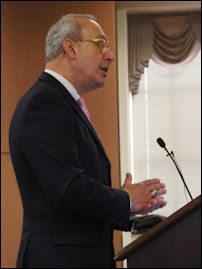by James A. Bacon
Effectively pulling the plug on the proposed Charlottesville Bypass, the McAuliffe administration has set up an advisory panel to recommend improvements to the U.S. 29 corridor north of Charlottesville. Lead by former Virginia Department of Transportation Commissioner Philip Shucet, the group must submit recommendations by May 14 — less than two months from now.
The Federal Highway Administration told VDOT in February that it would have to conduct a complete environmental assessment before receiving approval for the 6.5-mile bypass around the traffic-snarled highway north of Charlottesville, a process that could take a year or longer and offered no guarantees of approval. “We’ve studied this project for 20 years,” said Transportation Secretary Aubrey Layne today in the March meeting of the Commonwealth Transportation Board (CTB). “We have to have action taken.”
To move things quickly, Layne appointed a 10-member panel comprised of local government officials, planners and representatives from the business community up and down the U.S. 29 corridor to develop recommendations that (1) improve mobility in the corridor and (2) can be accomplished within the $197 million previously allocated to the bypass. (Additional sums could come from the sale of Right of Way purchased years ago.) The panel will come back to the CTB with a proposal that the board can vote up or down, Layne said.
When it comes to navigating highway department bureaucracy, Shucet knows the ropes. He was popular as highway commissioner during the Warner administration, and won renown in Hampton Roads for reining in runaway spending on the Tidewater Tide light rail project and completing the project on time. The panel will hold three meetings, Shucet said. The first meeting will define “success factors” for the project. The second will narrow down proposals to a manageable number for closer analysis. And the third will present a “solution package” that can be presented to the CTB.
Although Shucet made no reference to it, there is a “solution package” already on the books: Places 29. Generated after an extensive community-involvement process before the McDonnell administration revived the long-dormant bypass, Places29 envisioned a multi-pronged strategy for dealing with congestion: adding separated-grade interchanges at the two most congested intersections, building parallel roads to divert traffic from the highway and making spot improvements to choke points.
However, given the fact that the advisory board is heavily stacked with business interests and elected officials from outside the Charlottesville-Albemarle area, there is no guarantee that the group will agree to pursue Places29. For starters, following all the plan’s recommendations would cost considerably more than $200 million. Secondly, panelists from outside the region are less likely to prioritize local congestion relief at the expense of moving freight quickly through the congested zone. As Layne himself said, “I am determined to bring this conversation back to mobility, congestion and economic purpose.”
During the public comment period, two members of the Albemarle County Board of Supervisors expressed their approval of the new approach. “We’re committed as a board to helping you move forward to find a solution quickly,” said Brad Sheffield, a newly elected supervisor who ran in opposition to the bypass. “We’re on board with you.”
Cost overruns were a significant concern for the McAuliffe administration. VDOT staff had warned higher-ups that the problems could drive up project costs by as much as $200 million higher than preliminary cost estimates. Then-Transportation Secretary Sean Connaughton tried to finesse the issue by structuring the bypass as a design-build project allowing for creative solutions from the private sector. The Skanska-Branch Joint Venture won the contract with a bid that came in within the $197 million allocated by the CTB but close examination later revealed issues with its new design that would significantly degrade safety and the time-savings of the bypass, which would cost tens of millions of dollars to fix.
“The road proposed was not meeting the needed purpose for the amount of expenditure,” Layne said. “We need to match the resources available to us to the need.”



